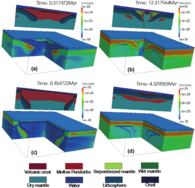Plume induced subduction initiation on modern Earth
Plume induced subduction initiation on modern Earth
Despite its importance, many aspects of subduction remain poorly understood, and the most controversial questions involve where new subduction zones initiate and how this process proceeds. 3-d thermo-mechanical models investigate the conditions leading to plume-induced subduction initiation in the modern Earth. They show four different deformation regimes in response to plume–lithosphere interaction: a) self-sustaining subduction initiation, in which subduction becomes self-sustaining; b) frozen subduction initiation, in which subduction stops at shallow depths; c) slab break-off, in which the subducting circular slab breaks off soon after formation; and d) plume underplating, in which the plume does not pass through the lithosphere and instead spreads beneath it (i.e., failed subduction initiation). The outcomes of the numerical experiments are applicable for subduction initiation in the modern and Precambrian Earth and for the origin of plume-related corona structures on Venus.

